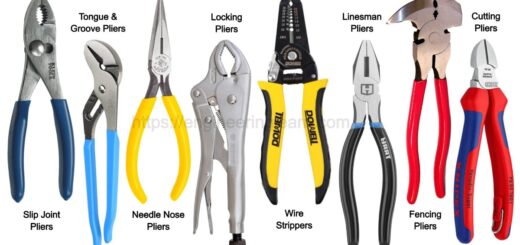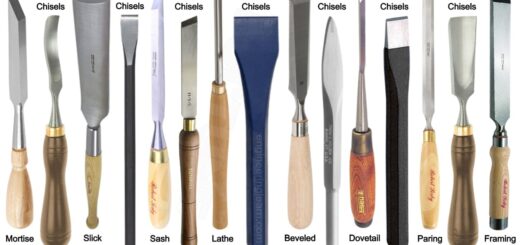Types of Bolt Cutter: Definition, Parts, Uses, Working [with Pictures]
![Types of Bolt Cutter: Definition, Parts, Uses, Working [with Pictures]](https://engineeringlearn.com/wp-content/uploads/2021/07/Bolt-Cutter-1024x539.jpg)
What is a Bolt Cutter?
Types of Bolt Cutter: Definition, Parts, Uses, Working [with Pictures] :- A Bolt cutter is also often known as a Bolt cropper. They are heavy duty, hand-held cutting tools which can easily be sliced through hard metal objects such as chains, bolts, rods and padlocks. They typically have short blades and long handles.
Working of Bolt Cutters
Bolt cutters do not cut through materials as a scissor do but they crush through the material by the concentration of huge forces on the small area of contact of blades. The standard long handles and compound hinges (joints provides more power to the jaws) work collectively to provide bolt cutters a significant cutting force.
Their cutting power is achieved by the principle called “leverage”, which means a modest amount of force applied over a long distance (in this case, it is the length of the handles) is converted into a massive force over a short distance (in this case, the jaws).
Uses of Bolt Cutter
Bolt cutters are extensively used in many different areas such as shipping (for opening sea containers), farming (for working on fencing)and electrical and building trades (for cutting metal wires and other structural materials).
They are particularly used in construction works which require tough and repetitive tasks such as cutting to size thick steel mesh panels, used in RCC.
Parts of Bolt Cutter
1. Jaws
The jaws constitutes the head of a bolt cutter and are forged discretely by the handles. Neck is the part where the blades are connected to the handles. They are kept in place by a pair of bolts. Just like a pair of scissors, connected by a single bolt, the compact bolt cutter carrying blades and the handle diagonally opposite are forged to make one piece.
2. Blades
The blades perform the actual cutting function. They are made extremely hard and they come in a variety of configurations (such as Centre cut, shear cut, etc.) to make them suitable for several uses.
3. Joints
Most of the bolt cutters contains multiple joints which are important for the strength of the tool, since they multiply the force given to the handles.
There are Three Key Joints:
- The handle bolt joint which connects the two handles
- The middle bolt joint which attach the jaws to the handles
- The jaw joint bolt joint which keep the blades aligned.
All three joints act as pivots while opening and shutting the jaws. This compound arrangement helps to magnify the force that the user applies to the handles of the tool much more than a single hinge does. The jaw joint bolts faces great strain from different directional forces as they allow the jaws to open while holding them flat.
4. Adjustment Bolts
Majority of the bolt cutters except the fixed-head compact type cutter consists of one or two adjustment bolts on the neck which can alter the angle of the blade they are nearest to. Whereas tools having two bolts, both blades can be adjusted. In addition to it, the bolts on the jaw plates can be turned which adjusts the gap between the blades.
These all are eccentric bolts, which means they have an irregular shaped shank similar to a cam. One of the bolt cutter blade moves as the bolt is turned. Adjusting the jaws using either set of bolts helps to counter-balance for sharpening, or can finely tune the bolt cutter to permit them to fix about thicker pieces of material.
5. Handles
Bolt cutter handles vary both in length and in the material of which they are made. This makes a significant difference in their weight and usability. Longer lengths are very helpful for cutting materials which are down low/up, out of reach or require a substantial amount of force, while short pairs are lightweight and useful for diluent materials which can easily be reached.
6. Handle Stops
Regular long-handled bolt cutters often have a pair of metal stops at the neck or a short way down the handles. These stops the handles and blades from moving too near to each other and coinciding at the end of a cut.
7. Handle Grips
For extra comfort and control of tool, most long-handled bolt cutters have rubber grips at the end of the handles.
Types of Bolt Cutters
In most cases, the shape of the blade defines bolt cutter’s type. Listed below are the types of bolt cutters:
- Centre Cut Bolt Cutters
- Clipper Cut Bolt Cutters
- Angled Bolt Cutters
- Shear Cut Bolt Cutters
- End Cut Bolt Cutters
- Ratchet Bolt Cutters
- Compact Bolt Cutters
- Manual Bolt Cutter
- Hydraulic Bolt Cutter
1. Centre Cut Bolt Cutters: ( Types of Bolt Cutter )
Bolt cutters with Centre cut blades are very popular and a multi-purpose option. They are effective because of the four slanted blade edges (the double bevel on each blade) put force equally on the material being cut, eventually making their way through on two sides of the item. They are best suited for a variety of operations such as cutting through things like rods, thick cables and pipes.
2. Clipper Cut Bolt Cutters: ( Types of Bolt Cutter )
In this type of cutter, the upper faces of both blades slants down to the flat sides of the jaws. The lower edges of the blades create a significantly thin edge which permits the tool to employ as much pressure as its Centre cut counterpart. It means that the cutting point is close to the surface when the tool is flat on the surface, making the cut blades ideal for cutting through projecting nails, bolts or screws near to the surface of a workpiece.
3. Angled Bolt Cutters: ( Types of Bolt Cutter )
If the head of the bolt cutters is angled and is designed with no surface plate underneath then the blades are able to make an even lower cut. This type of tool can snip off bolts or nails almost completely to the surface they are protruded in.
For cutting things like nails projecting from boards, a pair of bolt cutters with an angled head is mostly useful. This lifts the handle up from the surface on which the work is being done at an angle of 20 or 30 degrees to the head, leaving quite room underneath for a hand to make a grip on the tool.
4. Shear Cut Bolt Cutters : ( Types of Bolt Cutter )
Shear cut bolt cutters are the ideal tool for cutting wire cables. Rather than making the blades press against each other, like scissors blades are designed to overlap and slide through.
These tools are often used to cut through cables, which they can do cleanly and precisely as they slice rather than cut. The hooked shape of the jaws helps in holding the cable in place during the cutting process.
5. End Cut Bolt Cutters : ( Types of Bolt Cutter )
End cut bolt cutters jaw consists the end of the blades flattened. The flattened blade is turned inside to make a pincer-style head. They are used to grip onto the material and then clipping them off such as bolt heads which are in a narrow place that are difficult to access and cannot be approached with other cutters such as Centre cut or clipper cut heads.
6. Ratchet Bolt Cutters: ( Types of Bolt Cutter )
Bolt cutters having ratchet hinges which allows the user to apply pressure in short bursts rather than applying force for a longer period of time. These are generally more costly than the bolt cutters without this feature.
7. Compact Bolt Cutters: ( Types of Bolt Cutter )
Bolt cutters are referred to as compact bolt cutters if they have handles ranging around 200m (or less, although this is the minimum size commonly used). These type of tools are designed for lighter work, like cutting through fencing wire or thin lock. They are lighter in weight than standard bolt cutters and ideal for use in the home and garden works.
8. Manual Bolt Cutter: ( Types of Bolt Cutter )
Manual bolt cutters have applications in a wide area. There are a number of types and sizes of bolt cutters to deal with majority of the household works. They also find their applications in construction works. When the cutting task is difficult and dangerous, however the builders as well as the emergency services switched to a powered tool.
9. Hydraulic Bolt Cutter: ( Types of Bolt Cutter )
Hydraulic bolt cutters have powerful motor-engines having a rechargeable battery and are mostly cordless and convenient to work with. The jaws of hydraulic bolt cutters mostly work in a guillotine manner, with a flat blade or blades slicing powerfully through the material which is to be cut.













